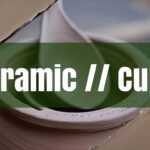Crafting your own pottery cups is a deeply rewarding experience, connecting you to the earth and the history of human creativity. Whether you’re drawn to the rustic charm of hand-built pieces or the sleek precision of wheel-thrown forms, this guide will provide a foundation for your ceramic journey. From selecting the right clay to mastering glazing techniques, we’ll explore the essential steps to create functional and beautiful pottery cups. You can also read more about functional pottery design here to inspire you.
The Right Tools and Materials
The journey begins with gathering the right tools and materials. Clay, the heart of pottery, comes in various types, each with unique properties. Stoneware clay is often recommended for beginners due to its versatility and durability, firing at temperatures between 1100°C (2000°F) to 1300°C (2370°F) (Soul Ceramics). It’s strong, non-porous, and can withstand multiple firings, making it ideal for cups. Amaco’s Stoneware Buff Clay and White Clay are also good choices, as they are smooth and easy to work with (Pottery Crafters). Earthenware clay, like terracotta, offers a rich color but requires glazing to be waterproof due to its porous nature and should be fired at approximately 1100 °C (2000 °F) (Soul Ceramics). Porcelain, prized for its delicacy and translucency, is more challenging to work with but yields stunning results when fired at higher temperatures, typically between 1,200 °C (2,200 °F) to 1,400 °C (2,550 °F) (Soul Ceramics). Besides clay, you’ll need essential tools such as aprons to protect your clothing, wire cutters for slicing clay, sponges for smoothing, ribs for shaping, and various modeling tools for detailing. A kiln is indispensable for firing your creations, transforming soft clay into durable ceramic (Soul Ceramics).
Shaping Techniques
Hand-building offers several accessible methods for crafting pottery cups. The pinch pot method, perfect for beginners, involves starting with a ball of clay and using your fingers to pinch and rotate, gradually forming a hollow shape. Coil building involves rolling clay into long, thin coils and stacking them to build the walls of the cup, blending the coils together for a seamless look. Slab construction utilizes flat sheets of clay, cut and assembled to create geometric forms (Pottery Crafters). Each technique offers unique aesthetic possibilities, from the organic textures of pinch pots to the structured elegance of slab-built cups. For those seeking a different approach, wheel throwing offers the chance to create symmetrical, refined cups. This method requires practice and skill to master centering the clay on the wheel, pulling up the walls, and shaping the cup (Pottery Crafters). The wheel allows for thinner walls and more precise forms, but it also presents its own set of challenges, such as maintaining consistent thickness and preventing the cup from collapsing. For a deep dive, you can also read about mastering the art of pulled pottery handles.
Here’s a great video showing the entire process of making ceramics at home:
Surface Decoration
Once your cup is shaped, the real fun begins: surface decoration. Glazing is a transformative process, adding color, texture, and functionality to your pottery. Common glazing techniques include dipping, pouring, brushing, spraying, splattering, stippling, sponging, and trailing, each offering unique visual effects (Diamond Core Tools). Dipping provides an even base coat, while brushing allows for intricate designs. Decorative techniques like glaze trailing, where glaze is applied through a fine-tipped bottle, and wax resist, which creates patterns by repelling glaze, add personalized touches. Beyond glazing, you can carve designs into the clay surface, apply underglazes for colorful details, or even incorporate found objects for unique textures.
Firing and Ensuring Food Safety
The final step in creating your pottery cup is firing it in a kiln. This process transforms the fragile clay into a durable ceramic. Typically, pottery undergoes two firings: a bisque firing, which hardens the clay for glazing, and a glaze firing, which melts the glaze and bonds it to the clay body (Soul Ceramics). Firing temperatures vary depending on the clay and glaze used (Soul Ceramics). To ensure your pottery cup is food-safe, it’s crucial to use glazes that are specifically labeled as food-safe and to fire them to the recommended temperature (Seattle Pottery Supply). This ensures that the glaze is fully vitrified, creating a waterproof and non-toxic surface for containing liquids and food.
Common Pitfalls and Solutions
Like any craft, pottery presents its share of challenges. Cracking can occur during drying or firing due to uneven thickness or rapid temperature changes. Warping can result from improper support during firing or using clay that isn’t suitable for high temperatures. Glaze imperfections, such as crazing (a network of fine cracks) or pinholes (small holes in the glaze), can arise from incompatible clay and glaze combinations or improper firing. To minimize these issues, ensure even wall thickness, dry pieces slowly, use appropriate firing schedules, and test your glazes on small samples before applying them to your finished cups (Seattle Pottery Supply).
Making pottery cups is a journey of exploration and discovery. Embrace the process, experiment with different techniques and materials, and don’t be afraid to make mistakes. Each cup you create will be a testament to your creativity and a unique expression of your artistic vision.





